Gauging how much water houseplants will need can be tricky. Some water-loving houseplants may need to be watered every few days during the growing season, while other plants that love dry soil may only need to be watered every month.
Add to that the fact that plant watering can vary significantly based on the time of the year and the growing containers you’re using, and watering your plants can almost feel like a guessing game!
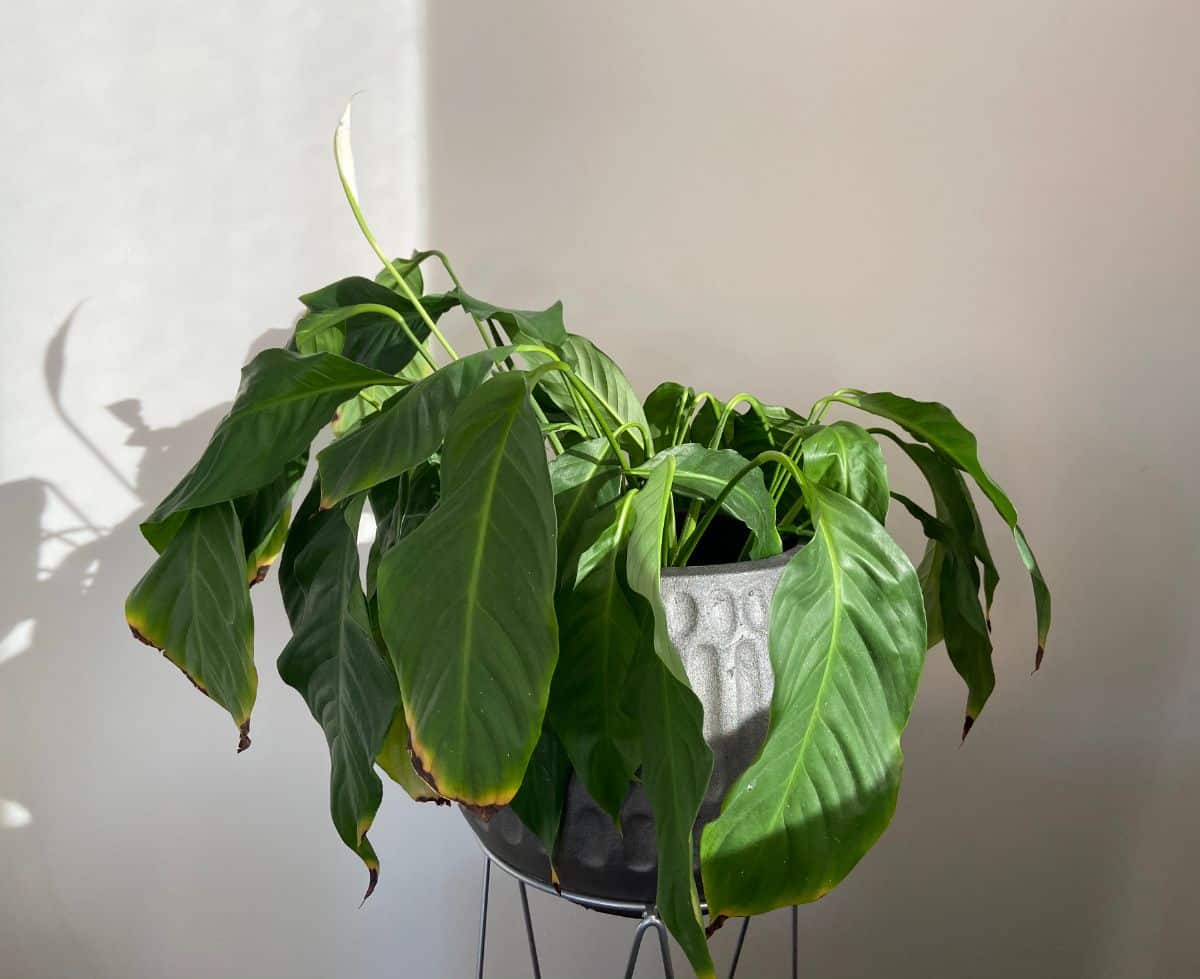
While there is definitely some variability in how much and how little water plants will need, there are some tried and true ways that will help you determine whether or not your plants need more water.
In this guide, we’ll walk you through some of the key signs you may notice if your plants need more water, but we’ll also give you some tips on how to make sure your houseplant soil doesn’t dry out too much in the first place.
By paying attention to your plants and using these simple plant watering tips, you’ll be watering your houseplants like a pro in no time!
Jump to:
- 6 signs that your houseplants need more water
- 1. Drooping and wilting.
- 2. Brown and crispy leaves.
- 3. Wrinkly succulents and cacti.
- 4. Hard, dry soil.
- 5. Stunted growth.
- 6. The pot feels light.
- How to keep plants from drying out
- Frequently asked questions
- What are the signs of root rot?
- Is Overwatering worse than Underwatering?
- How often should you water plants in pots?
- Is it better to water plants at night or morning?
- How do you revive a wilted house plant?
- What does a thirsty peace lily look like?
- Summary
6 signs that your houseplants need more water
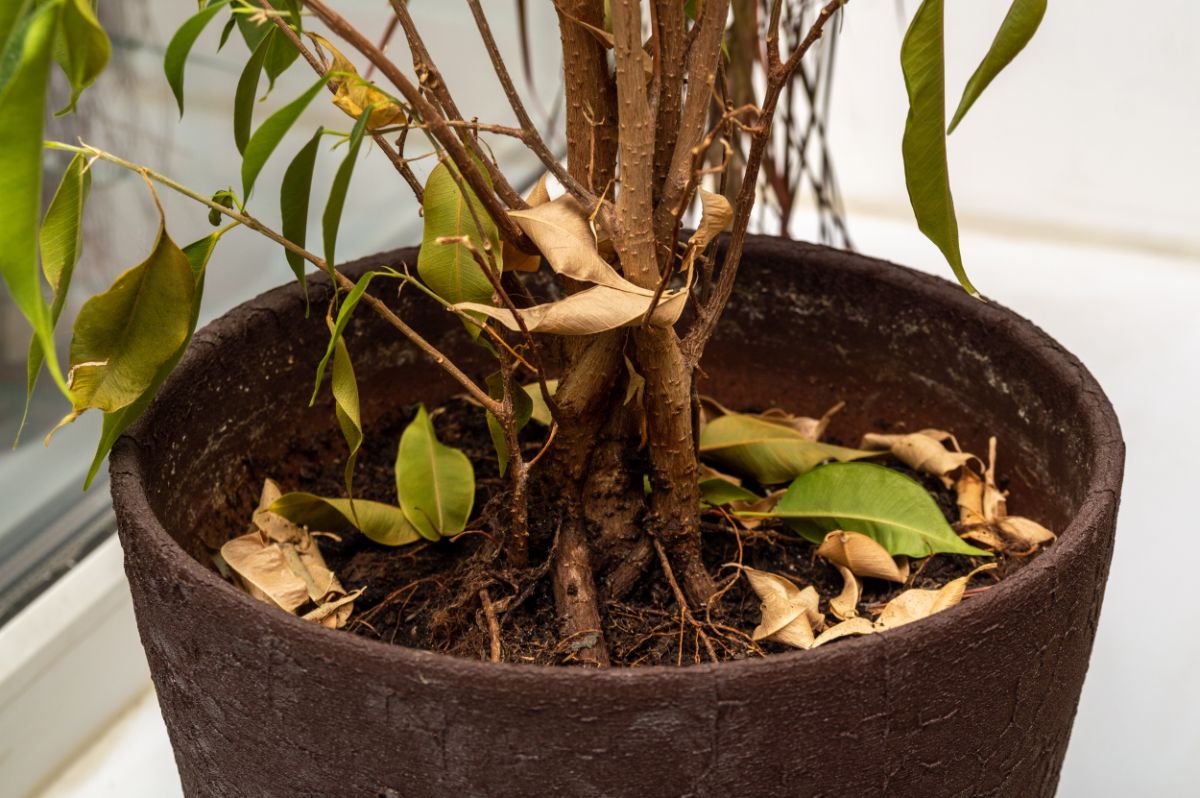
Plants need water to keep them upright, to move nutrients about their stems and leaves, and to photosynthesize in the sun. But water plants too much, and they’ll develop root rot; water plants too little, and they’ll be stressed out in other ways!
Most tropical houseplants will need to be watered about once a week, while succulents and cacti need to be watered much less than that. Hot temperatures, lots of sun, and A/C or heating units can all cause plant soil to try out too quickly, while plastic growing containers and poorly draining soil can make plants retain too much water.
If you know you haven’t watered your plants in a while, or if your plants display any of the following signs, it may be time to pick up your watering can and start watering!
1. Drooping and wilting.
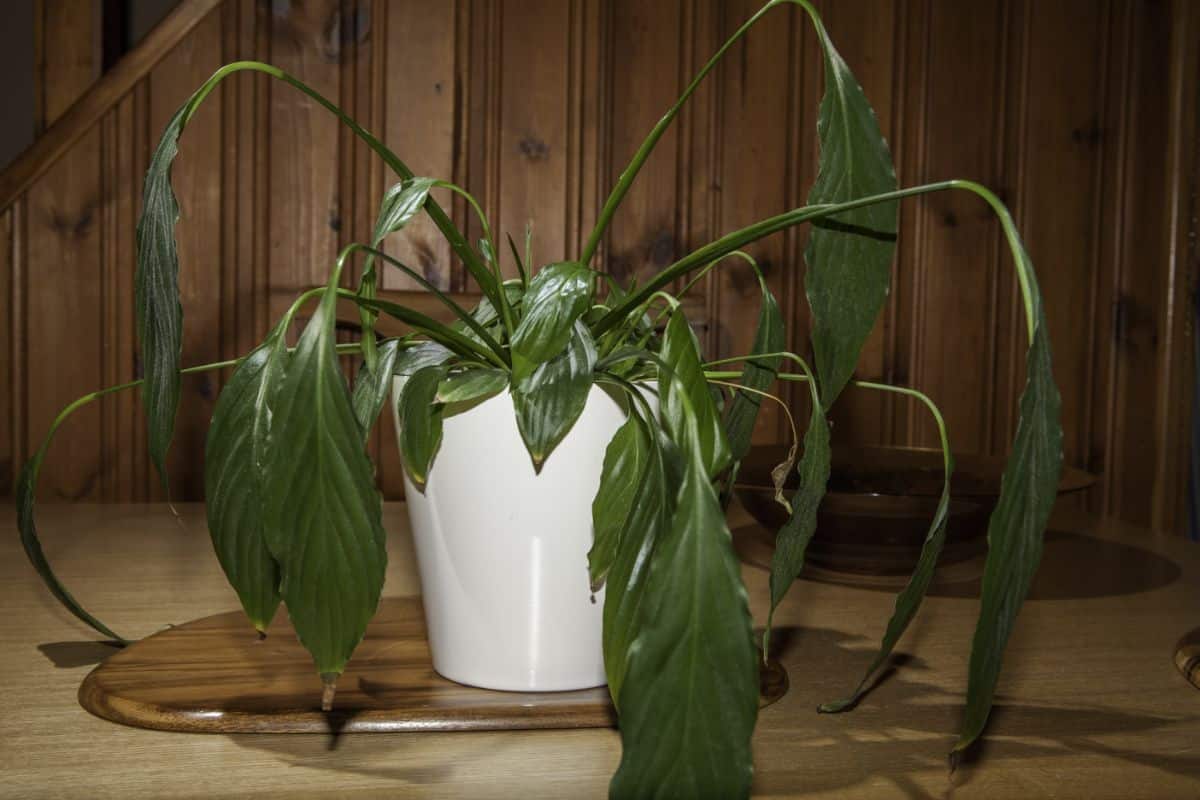
Plant cells have cell walls, and they absorb water through structures known as vacuoles. When plants have enough water in their cells, that water will press against the plant cell walls, and this creates something known as “turgor pressure.”
Turgor pressure helps keep plants growing upright and maintains the look and feel of plant leaves. However, if water levels drop and plants start to dry out, that turgor pressure diminishes, and plants may start to droop.
Not all plants will droop and wilt when they get too dry, but many tropicals will, and some plants can be very dramatic about it, too!
If you’ve ever kept nerve plants, waffle plants, or peace lilies, you know how quickly these plants can wilt when they don’t get enough water. But the good news is that if you water your plants at the first signs of wilting, most plants will bounce back quickly and look good as new in no time flat.
Also, keep in mind that plants will sometimes droop if they have been overwatered, which can make things a bit confusing. If you’re ever in doubt if your plants need more or less water, always feel the soil before you water again!
2. Brown and crispy leaves.
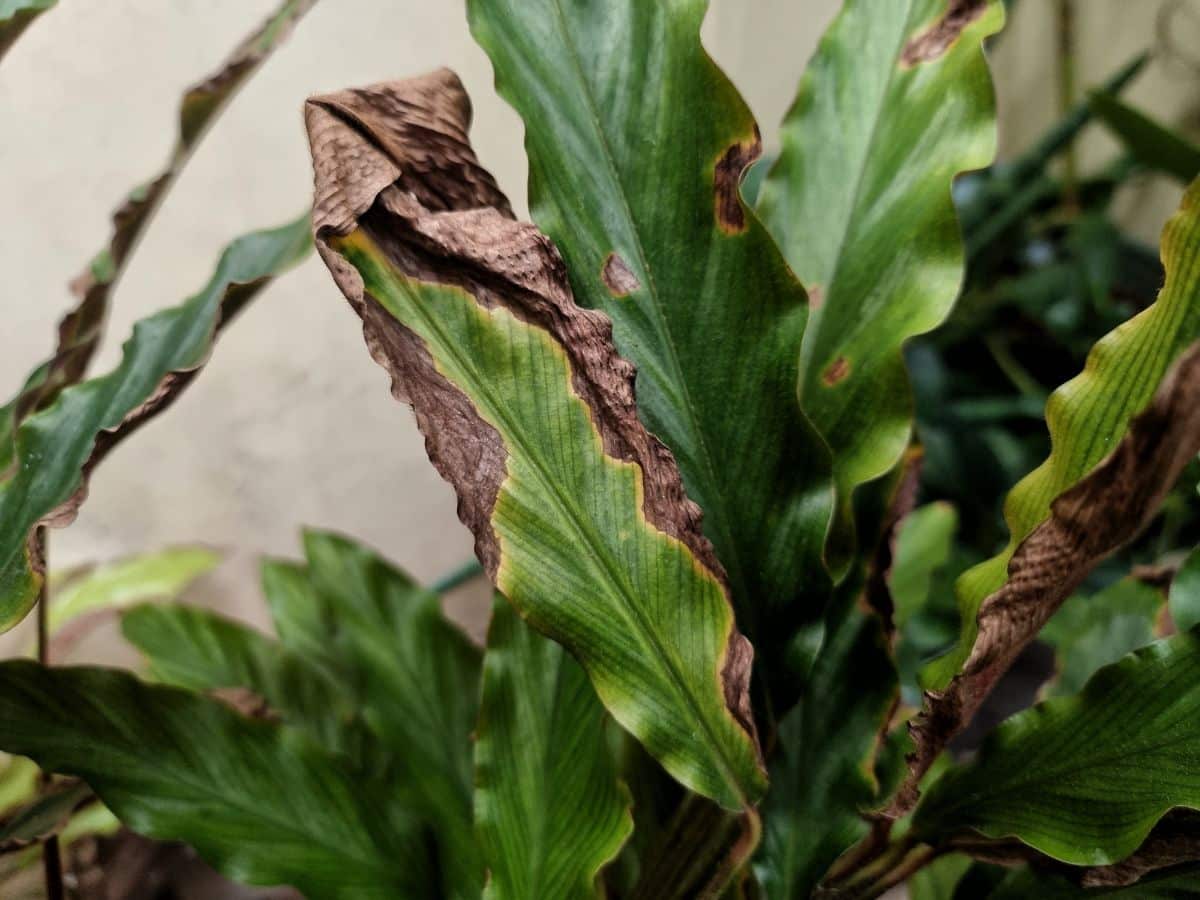
Plants that have started to wilt usually recover if you water them. But if you don’t water drooping plants, those drooping leaves will begin to turn yellow, brown, or develop crispy edges, and they may fall off the plant too.
On top of that, overly dry plants may also develop brown or crispy leaves even without wilting – this is especially common if you keep plants near an A/C or heating unit, where the air tends to be much drier.
Once plant leaves start to brown and dry out, those damaged leaves can’t be fixed. However, you can keep the problem from spreading by adjusting your watering schedule.
Damaged leaves should then be clipped away to keep them from drawing energy from your plant’s roots and to encourage your plant to produce new and healthy leaves.
While leaf browning and drying are often caused by underwatering plants, some other plant issues can also produce these symptoms.
Sunscald, pests, and fungi can cause leaf browning, and low air humidity levels can also make leaves dry out too fast.
If you think you’re watering your plants enough, but they’re still turning brown, try adding a humidifier or pebble tray to your growing setup to boost ambient humidity levels and check your plants over carefully for any signs of pests and disease.
3. Wrinkly succulents and cacti.
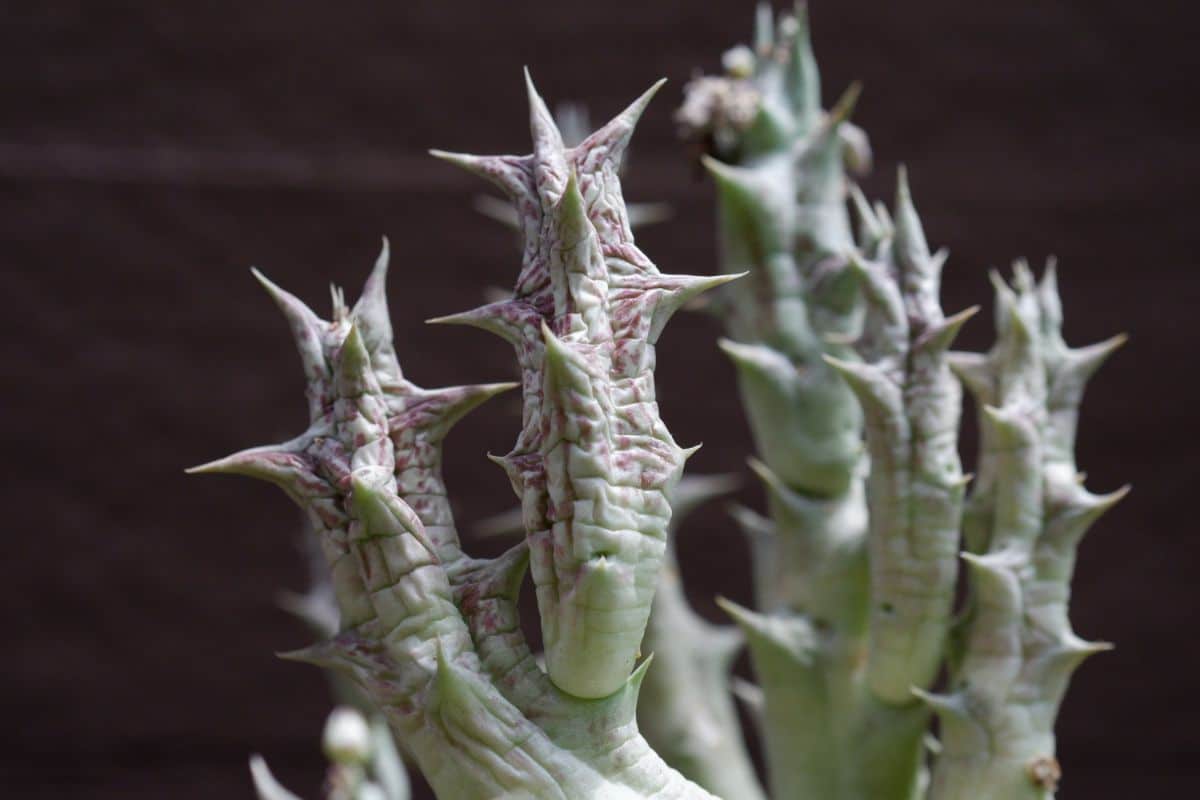
Tropical plants will often lose turgor pressure in their stems and wilt when they start to dry out, but succulents and cacti are such robust plants that they generally won’t droop in dry conditions.
Instead, succulents and cacti often respond to overly dry soil by becoming excessively wrinkly!
Everyone knows that succulents and cacti can get by with very little water, but they do still need some moisture. These plants use their stout trunks for water storage. As they dry out, they won’t have as much water to keep them plump, and they’ll start to wrinkle.
Wrinkling in cacti and succulents can be quite subtle (just a few ripples on a jade leaf, for instance), or it can be quite pronounced.
If you suspect that your succulents and cacti need more water, check the soil first to make sure it isn’t already moist. Sometimes, wrinkling can also occur when these plants are overwatered!
If the soil feels bone dry, water your succulents and cacti deeply and then allow the soil to dry out somewhat before you water them again.
4. Hard, dry soil.
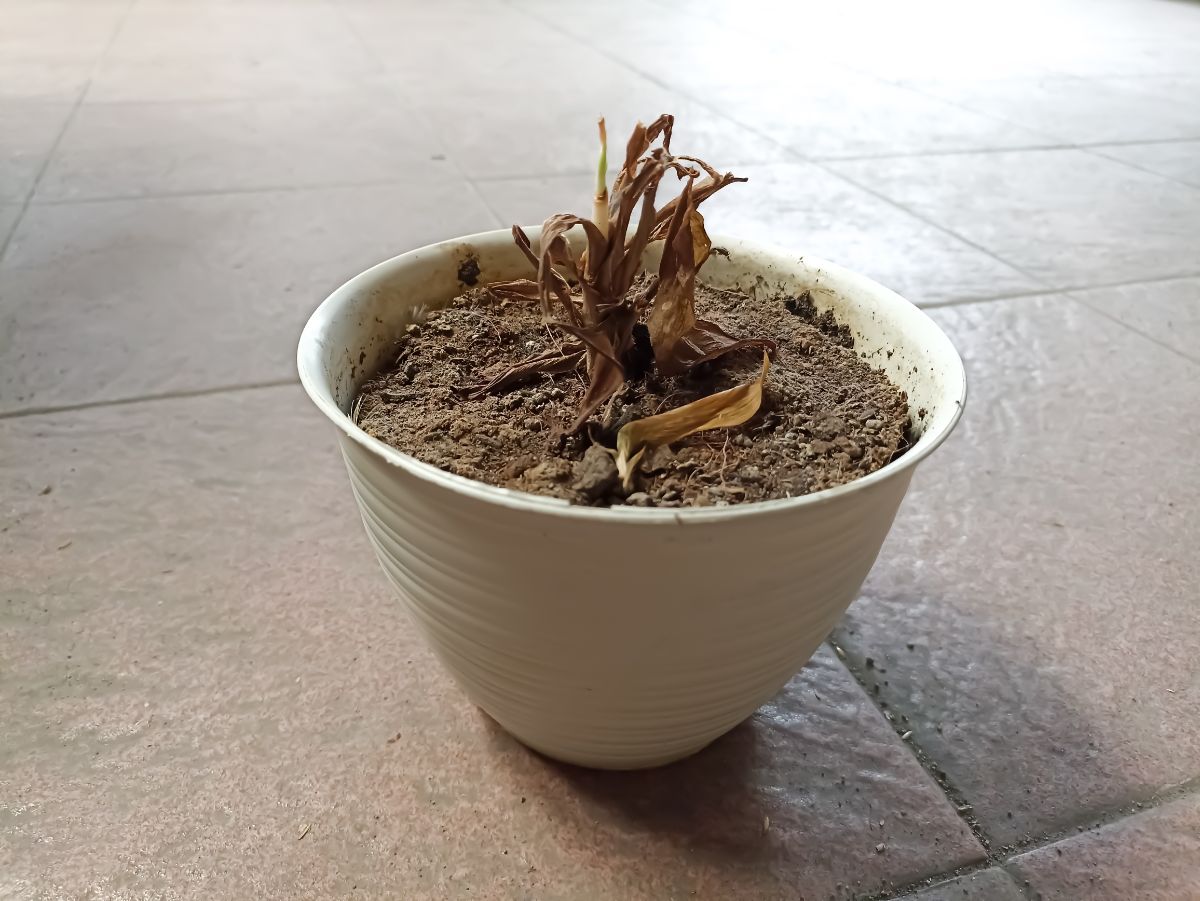
Of course, probably the most obvious way to determine whether your plants need more water or not is to feel your houseplant soil.
When plants aren’t watered often, soils can feel very dry, hard, and compact. If you water that parched soil, water may run right off or pool around the base of your plant and take a while to become absorbed.
For most tropical houseplants, a good rule of thumb for watering is to always test the soil before you add more water. You can do this by simply inserting your finger into the top 1 to 2” of your potting mix and then water your plants if the soil feels dry.
This technique doesn’t work as well for succulents and cacti as these plants need much less water, and they should be allowed to dry out some in between waterings.
Even if you water your plants regularly, you may notice that your potting mix doesn’t hold onto water well, and it may still feel dry. If this occurs, you may need to repot your plants into a fresh potting mix.
Over time, potting mixes can become depleted and compacted, and this can impair their ability to hold onto water and make plants dry out too quickly.
5. Stunted growth.
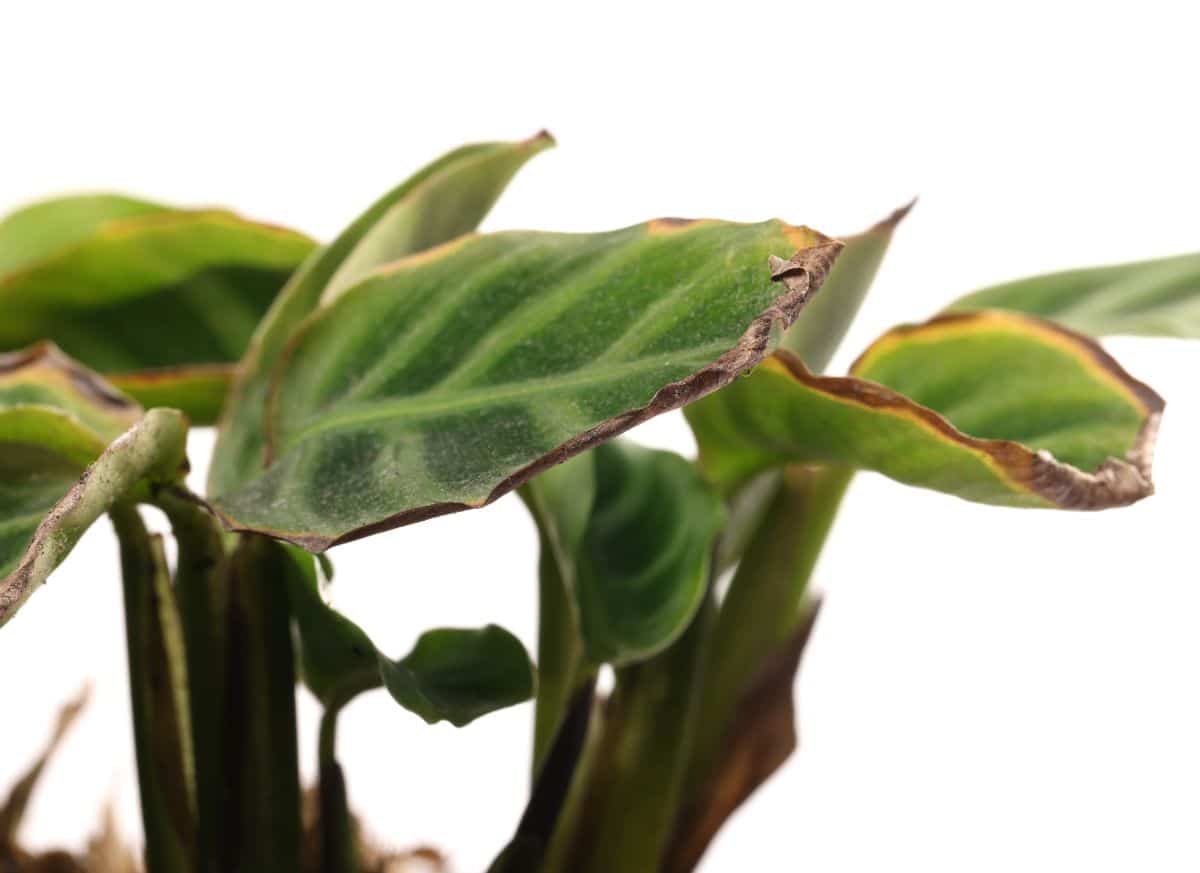
Plants need a balance of light, water, and nutrients to grow, but in the absence of water, plants won’t grow properly. If plants are severely underwatered, the signs will usually be obvious: wilting, drooping, and brown leaves.
However, if plants are regularly watered, but they’re not provided with enough water, symptoms may be more subtle, such as stunted growth.
Plants may become stunted due to many issues, including pests, diseases, and low light. But underwatering can also cause plants to stay small, and they may not flower as prolifically.
While this is not the most clear-cut sign that your plants need more water, it is something to keep in mind!
6. The pot feels light.

Feeling your plant soil with your finger can help you gauge whether your plant needs more water or not. But if you don’t want to get your hands dirty, you can also lift up your plant, pot and all.
This is not an exact science, of course, but if your plant feels particularly lightweight, it may be a sign that it needs more water!
How to keep plants from drying out

Underwatered plants can look very dramatic, Most plants will recover if you water them as soon as you notice signs of plant stress.
To keep your plants growing as healthy as possible, you’ll want to do what you can to make sure your plants always have the water they need. The following tips will help you regulate your plant watering schedule so you won’t forget to water your plants in the future!
- Do your research.
Some houseplants can get by with very little water, while other plants crave moisture. If you’re new to keeping houseplants or if you’ve recently purchased a plant type that you’ve never grown before, it’s always a good idea to do a bit of research to determine what your plant needs to look its best.
If you’re lucky, plants may come with a growing tag when you pick them up from the plant nursery. These tags often have suggestions about how much water and light your plants will need.
If your plant doesn’t come with a tag, you can always research your plant’s watering needs online or ask for watering advice from online gardening groups.
- Rearrange your plants.
If you keep lots of houseplants and they have different watering needs, you can streamline your watering process by rearranging your plants a bit.
Move plants that need the most water into a convenient place where you can water them as often as they need. This will also make it much more likely that you’ll notice subtle signs of underwatering, like minor leaf drooping.
Since A/C units and heaters can cause plants to dry out more quickly, you may also want to move houseplants away from these devices. For even easier plant care, try keeping water-loving plants in terrariums, vivariums, or grow cabinets where water won’t evaporate as quickly.
- Mark your calendar.
As any indoor gardener knows, it’s far too easy to forget to water your plants! If you often find that you forget about watering entirely, you may want to swap out your tropical houseplants for plants that can get by with less water, such as succulents.
That said, if you love keeping tropicals, you may have better luck remembering to water them if you mark your “watering days” on your calendar. Marking plant care notes on a calendar is a great way to keep yourself organized, and it can also be handy if you ever need to hire a plant sitter.
If you don’t think a calendar will be enough to remind you to water your plants, you can also try out plant care phone apps. Many of these apps will send you gentle reminders (or not-so-gentle alarms!) when it’s time to water your plants!
- Do a finger test.
Because overwatering and underwatering can be such a problem with indoor plants, always check the soil on tropical plants before watering by inserting a finger into the top 1 to 2” of the potting mix. If the soil feels dry, it’s time to water!
- Use a soil moisture meter.
Testing houseplant soil with your fingers can help you assess soil moisture levels, but it isn’t always that precise. If you’d like to be even more exact with your plant watering regimen, you may also want to invest in a soil moisture meter.
These handheld instruments can be inserted right into your plant soil, and they’ll let you know in a few seconds if your plant needs more water.
- Try self-watering pots.
One way to work around being a forgetful garden is to automate as many tasks as you can. And when it comes to watering houseplants, you can easily “automate” watering by keeping water-loving plants in self-watering planters!
Self-watering planters often have a water reservoir for water storage and an easy-to-read water gauge that will let you know when the water reservoir runs dry.
Plants grown in these pots often only need to be watered every few weeks or every few months, depending on the size of the pot’s water reservoir. Just keep in mind that these planters work best for tropical plants, and they may provide too much water to succulents and cacti.
If the thought of using self-watering plant pots has you intrigued, we have a full guide on these efficient planters right here.
- Use a self-watering system.
Self-watering planters can be super useful if you just have a few plants in your houseplant collection. However, if you have a large collection of houseplants that need watering or you are a frequent traveler who needs to automate plant watering once and for all, there is another option. Self-watering planter systems!
Self-watering systems work much like drip irrigation systems intended for outdoor gardens, but these systems are specially designed for houseplants and indoor use.
With easy-to-use timers, self-watering systems run mostly on their own, and they need very little interference from you. And even better, they can be connected to lots of plants (many systems fit a minimum of 15 plants), allowing you to water your plants in a truly hands-off way!
Frequently asked questions
What are the signs of root rot?
When plants develop root rot from being overwatered, they will often droop, yellow, drop leaves, and stop growing, and they may develop mushy or smelly roots. These symptoms look very similar to the symptoms of underwatering, and this can make it difficult to know exactly what’s going on with your plants!
The easiest way to tell if your plants have root rot is to feel the soil for excessive dampness and inspect the plant’s root systems for signs of rot.
Is Overwatering worse than Underwatering?
Underwatering and overwatering can both do a lot of harm to plants; however, overwatering is more likely to do irreversible damage. If plants are underwatered, they’ll often recover if you water them again. But if plants have been significantly overwatered and root rot has set in, the plant’s root system may be unsalvageable.
How often should you water plants in pots?
Watering schedules can vary significantly depending on the plants you’re growing, the time of the year, the pots your plants are growing in, and other factors. In general, most tropical plants will need to be watered about once a week, while succulents and cacti should be watered every few weeks or even every few months!
Is it better to water plants at night or morning?
Morning watering is usually the best option for houseplants since plants will have plenty of time to absorb moisture before nightfall, and any moisture on plant leaves will evaporate, limiting the chances of mildew issues.
Evening watering can also work, but be sure to direct your watering can toward the soil line and keep plant leaves as dry as possible. The worst time to water plants is during the heat of the day when the sun is high overhead.
How do you revive a wilted house plant?
If plants are wilted due to underwatering, they will often bounce back if they’re provided with a good, deep drink of water. But if plants are wilted due to pests, diseases, or overwatering, you may need to treat your plants a bit differently.
Overwatered plants with root rot, for instance, may be unfixable, but you can often salvage these plants by taking stem cuttings and rooting them.
What does a thirsty peace lily look like?
Peace lilies literally tell you when they’re thirsty by wilting dramatically. Stems and leaves will get floppy, and they may even droop over the pot’s sides.
Most of the time, peace lilies will perk right up when they’re watered again, but if they’ve been underwatered for a while, they may exhibit browning or crispy leaves that will need to be pruned away.
Summary
Finding that perfect watering balance with houseplants may take some time, but if you know what underwatered and overwatered houseplants look like, plant watering becomes much easier.
Plants may not have the ability to speak to us, but they do have their own unique ways of telling us exactly what they need. Once you get comfy with your plants, minor leaf discoloration, drooping leaves, and other signs of underwatering will become so clear it’s almost like your plants actually asked you for a glass of water!
We hope you found these plant watering tips helpful. But if still struggle with watering houseplants, you may want to try your hand at growing low-water plants like succulents and cacti!

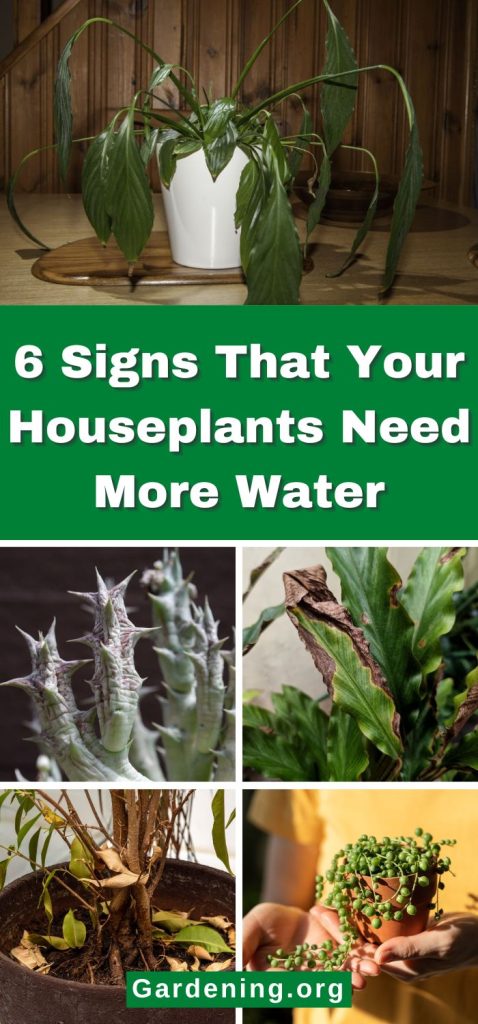
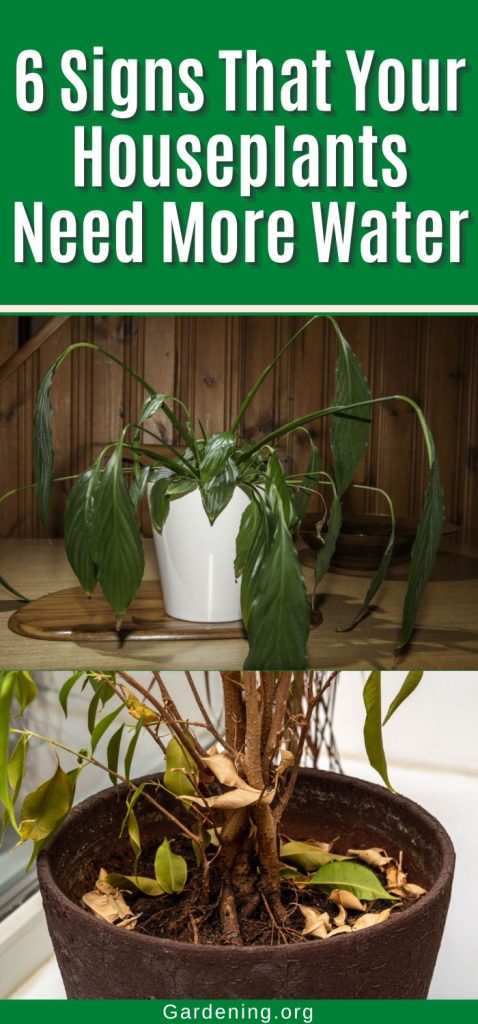
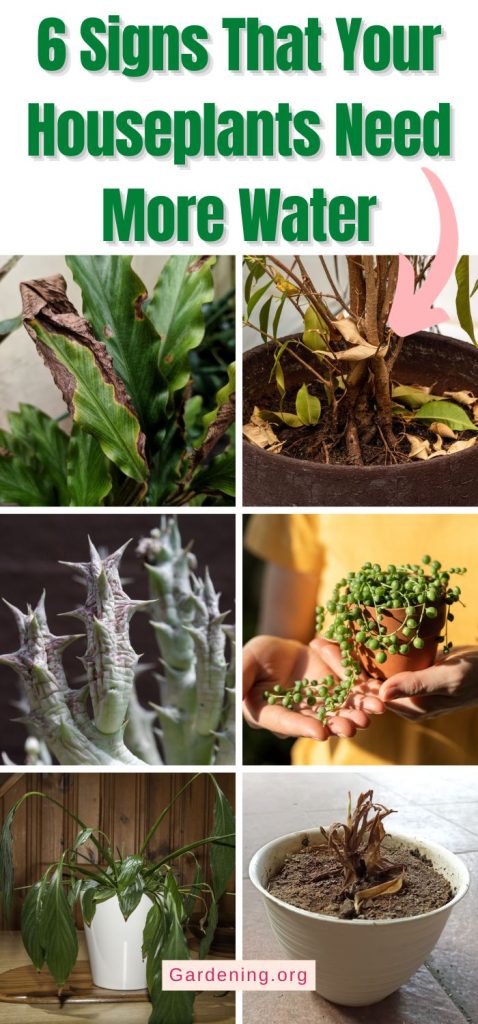
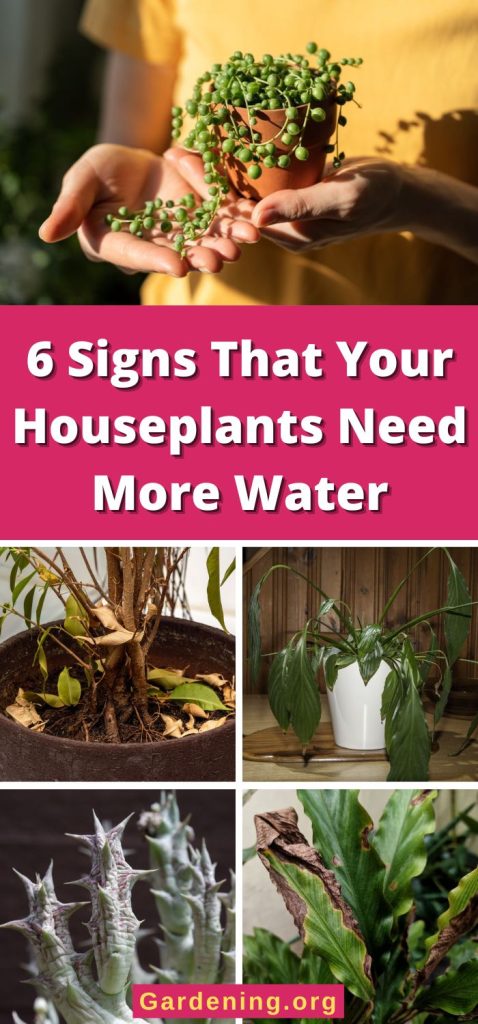
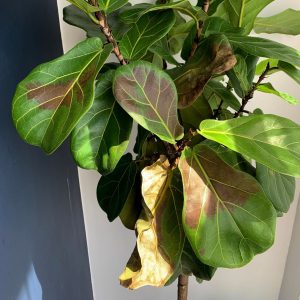
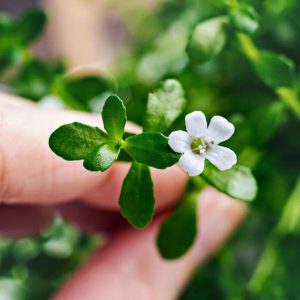
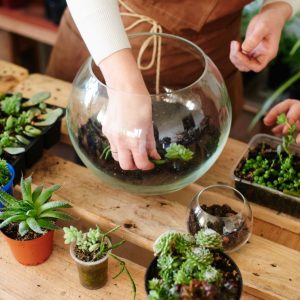
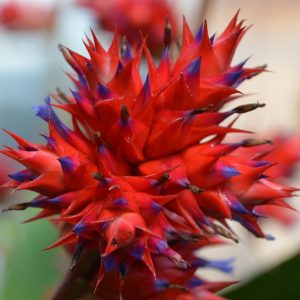
Leave a Reply